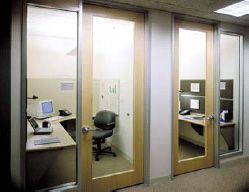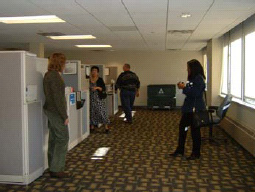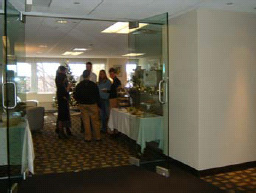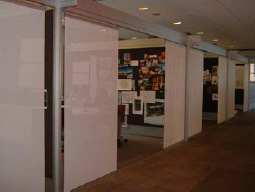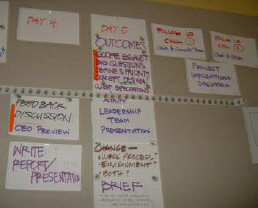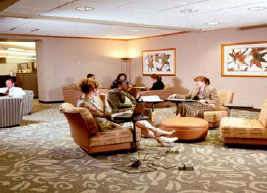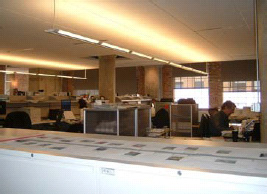Collaborative Knowledge Work Environments
The Importance of Collaboration
Collaboration is perceived as a key to organizational effectiveness in an increasing number of work contexts - from service and policy making organizations to scientific research and development groups. Although collaboration is defined as "working together", effective collaboration entails both individual, focused tasks and interactive group work. Accordingly, collaborative work environments require spaces, furnishings and technologies that support both individual focus and group interaction, while also facilitating transitions between these activities. Finding the right balance and types of support for individual and group work requires an understanding of both social and cognitive processes.
The Social Components of Collaborative Work
Effective collaboration involves three related types of social behaviors: awareness, brief interaction, and collaboration (working together).
Awareness involves knowing what is happening in the surrounding space as well as the meaning of events and actions. Processing of this information is primarily through peripheral channels and is used to maintain an on-going knowledge of others - locations, activities and intentions.
Spatial features that promote awareness include
- Good visual access into surrounding spaces.
- Visible displays of information
- Group work surfaces
- Signals of presence (lights, computers on)
Organizational factors that warrant high visibility:
- A dynamic task environment.
- Work urgency requires high visibility of people and information
- Need for continual feedback
- High need for transparency of operations
- High need for coordination of tasks
Benefits of high awareness:
- Improved coordination
- Rapid information sharing
- Increased observational & tacit learning
- Ability to see when people are having problems
Potential concerns and constraints:
- Loss of privacy
- Distractions & interruptions
- Noise from others talking
Brief Interactionsare largely unplanned and occur as part of the natural behaviorsystem of knowledge work as people ask questions, check facts, set up meetings, and joke with colleagues during the work day. Brief interactions aid information flow, spark new ideas, promote internal learning, and aid the development of working relationships.
Spatial features that promote interaction include:
- Proximity of workers to one another Visual access into space to aid eye contact
- Visually open workstations, such as bullpens or pods
- Central entrances and pathways that increase theprobability of encounters
- Group members located within 90 ft of one another
- Central, open stairways
- Layouts and design that promote efficient wayfinding landmarks, color variation, variation in decor)
Organizational factors that warrant high interaction:
- High need for coordination of tasks
- Time pressures
- High task uncertainty
- Multidisciplinary work groups
- Need for rapid assimilation of new knowledge
- High demand for innovation
Benefits of high levels of face to face interaction:
- Increased learning
- Improved information flow
- Improved ability to know what is going on in the organization
- Improved group decision making
- Higher-bandwidth communication
- Improved process integration across units
- Increased sense of comaraderie
- Greater likelihood of developing friendships at work
Potential concerns and constraints:
- Reduced time on individual tasks
- Increased distractions
- Increased need to work extra hours to compensate forloss of individual task time
- Potential for increased stress
- Potential for over-communicating beyond what is valuable
Collaboration
The specific features of collaborative spaces and their successful implementation vary according to the nature of the work. Key considerations include:
On-going communication needs. The need for rapid, continuous information sharing, group problem solving, monitoring progress, and pressures for reduced product/project time are factors favoring easily accessed group workspaces, shared information displays, and dedicated project rooms.
Cognitive complexity of the group task. Multi-disciplinary understanding and complex problem solving are likely to require group technologies and tools, including information displays, surfaces for tracking progress, shared databases, and visualization technologies.
The task structure. Highly interdependent tasks benefit from spaces that support on-going coordination, rapid. problem solving, and prompt feedback on information requests.
Spaces specifically designed for collaboration include project rooms, informal teaming spaces, open bullpen workstations, and the high technology mobile workspace.
Project Rooms
Project rooms normally have shared information displays for tracking project assignments and progress, project files, and access to organizational databases. In some cases rooms are assigned to a project for its duration. For shard project rooms other means of rapidly restoring shared group information are important, such as portable or electronic display surfaces.
Organizational factors that warrant project rooms:
- Pressure to reduce time to market
- Highly interdependent work processes
- Need to track progress on multiple tasks
- High need for shared access to databases
- High need for group problem solving
Benefits of project rooms
- Easy access to team members
- Quick response to questions
- Sustained group memory due to information display
- Improved project tracking
- Improved task coordination
Concerns and constraints:
- Potential for information overload
- Reduced time on individual tasks
- Reduced privacy and concentration
Informal interaction spaces.
These spaces typically have comfortable furnishings and are located in open areas adjacent to private workspaces. The intention is to encourage and support spontaneous meetings in a more relaxed atmosphere than formal conference rooms.
Benefits of informal spaces:
- Ability to meet rapidly without scheduling a room
- Ability to draw in passersby
- Flexibility can rearrange the space to suit needs
Concerns and constraints:
- Noise from meeting may disturb those working nearby
- Loss of privacy/confidentiality for group work
- Cultural constraints may discourage use, especially if people are perceived as "not working"
- Spaces are most useful if located adjacent to people who work together and are likely to have unplanned meetings
Bullpen workstations
Bullpen workstations have low or no partitions between individual workspaces, but may have higher partitions separating the groups.
Benefits of bullpen spaces:
- Easy communication among group members, especially about on-going tasks
- Enhanced ability to judge whether others are availablefor conversation
- Enhanced access to daylight and views
Concerns and constraints:
- Difficulty for work requiring concentration
- Increased overall distractability
- Loss of privacy and confidentiality
- Potential for over-communicating
High mobility workspaces
Past experiments on the high mobility, unassigned workspace approach have met with mixed success. In some cases, this was due to inability of workers to locate one another, or difficulty in moving work to new locations. A recent experiment by Cisco Systems in its Silicon Valley headquarters provides a glimpse into a model that combines mobile technologies with a highly flexible infrastructure. People working in the office do not have assigned workstations. Instead, they move about during the workday to a variety of spaces that suit changing individual and group needs. The space is supported with wireless network access, internet phones, and software that supports inclusion of colleagues located elsewhere on campus or globally. The group in the experimental space is discouraged from having paper files - in fact, all paper documents, including mail, are electronically scanned. Preliminary findings show high levels of satisfaction and greatly reduced real estate costs, largely due to the fact that there are fewer workstations than individuals assigned to the building. The office design is intended for groups that spend a considerable amount of time away from the workspace.
Sources:
- J. Heerwagen, K. Kampschroer, K. Powell and V. Loftness, 2004. Collaborative Knowledge Work Environments. Building Research and Information. 32(6): 510-528
- "Cisco Connected Workplace Enhances Work Experience and Cuts Costs." 2009, Case study, Cisco Systems, Inc.

